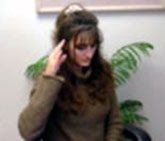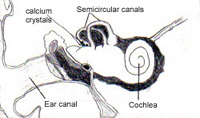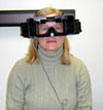|
Conditions & Treatments - Benign Paroxysmal Positional Vertigo |

Do you experience temporary episodes of dizziness, vertigo, loss of balance or nausea when you change the position of your head? If the answer is yes then you may have a condition called benign paroxysmal positional vertigo. This disorder can be diagnosed by a physician, physical therapist or audiologist. It is a condition which can be easily treated by a physical therapist. |
|
What is Benign Paroxysmal Positional Vertigo (BPPV)?  Benign paroxysmal positional vertigo is a disorder of the vestibular system where the calcium crystals in the inner ear of an individual break off and are free to float in the semicircular canal of the inner ear (Please refer to illustration). These calcium crystals can be dislodged by an injury to the head, aging, infection or by other disorders of the inner ear. However, in many of the cases the cause of BPPV is unknown.
For those with BPPV a change in the position of the head often results in the movement of these dislodged calcium crystals in the inner ear. When these crystals are moved they can brush up against hairs in the inner ear which detects movement and provides your brain with information on your body’s position. Because of the crystals brushing up on the hairs, the brain processes false information and compares this input with other systems. This contradictory information throws off the brain and elicits dizziness, vertigo, loss of balance, lightheadedness and nausea in the individual. Quite often a healthcare professional will see nystagmus, a rapid involuntary oscillation of the eye(s), when the position of the individual’s head is changed.
Diagnosis  BPPV can be diagnosed by a physician, physical therapist or audiologist. After a detailed history has been obtained and a physical examination conducted, additional specialized tests for the vestibular and auditory systems can be performed by the appropriate health care professional to further assist in diagnosing this condition. Medical tests can also be conducted and can include a MRI, electronystagmogram (ENG) or a video nystagmography (VNG). The picture provided displays an individual who is wearing specialized goggles for a VNG. These specialized goggles displays and records eye movements with positional changes of the head and can assist in diagnosing BPPV.
Treatment BPPV does resolve on its own in some cases. However, when treatment is required medications which help control symptoms can be prescribed, surgery (posterior canal plugging) can be performed to prevent movement of the crystals in the inner ear, and in most cases, physical maneuvers can be performed by healthcare professionals which can assist in relodging the crystals in the inner ear. Such physical maneuvers which are generally conducted by healthcare professionals, such as physical therapists, includes the Epley or Sermont Maneuvers. A home exercise which is prescribed by physical therapist for BPPV when the office treatment fails is called the Brandt-Daroff Exercise. This exercise is described below and can be viewed by clicking on the picture. It should not be performed unless your physical therapist or other health care professional has prescribed it. Please remember that by accessing the videos that you are agreeing to the terms and conditions of CyberPT.
 Brandt-Daroff Exercise1,2 (click on picture to access video) 1) From an upright seated position move into a side-lying position with your head angled upward about half way (nose is pointed up at about 45° angle). 2) Stay in this side-lying position for 30 seconds or until the dizziness subsides (could require longer than 30 seconds). Than go back into the sitting position. 3) Stay in the upright seated position for 30 seconds and then perform the same steps in the same way on the opposite side. 4) Perform five reps of the complete maneuver. 5) Perform this exercise in 3 sets per day for two weeks with each set consisting of performing the complete maneuver five times.
* Should the exercise fail to produce symptoms during a session, stop the exercise for that day. If no symptoms can be produced during the first session of the next day, then stop the exercises entirely.
1 rep = maneuver done to each side in turn (takes 2 minutes). Below is a suggested schedule.
Last revised: June 6, 2008
References 1. Brandt T, Daroff RB. Physical therapy for benign paroxysmal positional vertigo, Arch Otolaryngol, 1980, 106:484-485 (Brandt-Daroff Exercises) 2. Brandt, T, Steddin S, Daroff RB. Therapy for benign paroxysmal positioning vertigo, revisited. Neurology 1994, 44:796-800 |
|
|
|
|





